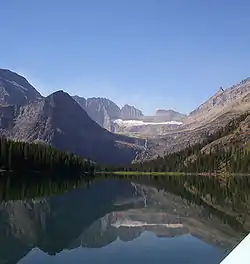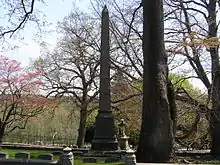George Bird Grinnell
George Bird Grinnell (September 20, 1849 – April 11, 1938) was an American anthropologist, historian, naturalist, and writer. Grinnell was born in Brooklyn, New York, and graduated from Yale University with a B.A. in 1870 and a Ph.D. in 1880. Originally specializing in zoology, he became a prominent early conservationist and student of Native American life. Grinnell has been recognized for his influence on public opinion and work on legislation to preserve the American bison. Mount Grinnell is named after Grinnell.[1]
George Bird Grinnell | |
|---|---|
 | |
| Born | September 20, 1849 Brooklyn, New York City, New York |
| Died | April 11, 1938 (aged 88) New York City, New York |
| Signature | |
 | |
Exploration and conservation
Grinnell had extensive contact with the terrain, animals and Native Americans of the northern plains, starting with being part of the last great hunt of the Pawnee in 1872. He spent many years studying the natural history of the region. As a graduate student, he accompanied Lieutenant Colonel George Armstrong Custer’s 1874 Black Hills expedition as a naturalist. He declined a similar appointment to the ill-fated 1876 Little Big Horn expedition.[2]:109
In 1875, Colonel William Ludlow, who had been part of Custer's gold exploration effort, invited Grinnell to serve as naturalist and mineralogist on an expedition to Montana and the newly established Yellowstone Park. Grinnell prepared an attachment to the expedition's report, in which he documented the poaching of buffalo, deer, elk and antelope for hides. "It is estimated that during the winter of 1874-1875, not less than 3,000 Buffalo and mule deer suffer even more severely than the elk, and the antelope nearly as much."[2]:102 His experience in Yellowstone led Grinnell to write the first of many magazine articles dealing with conservation, the protection of the buffalo, and the American West.

Grinnell made hunting trips to the St. Mary Lakes region of what is now Glacier National Park in 1885, 1887 and 1891 in the company of James Willard Schultz, the first professional guide in the region. During the 1885 visit, Grinnell and Schultz while traveling up the Swiftcurrent valley observed the glacier that now bears his name. Along with Schultz, Grinnell participated in the naming of many features in the Glacier region.[3] He was later influential in establishing Glacier National Park in 1910. He was also a member of the Edward Henry Harriman expedition of 1899, a two-month survey of the Alaskan coast by an elite group of scientists and artists.
Grinnell was prominent in movements to preserve wildlife and conservation in the American West. Grinnell wrote articles to help spread the awareness of the conservation of buffalo. For many years, he published articles and lobbied for congressional support for the endangered American buffalo. In 1887, Grinnell was a founding member, with Theodore Roosevelt, of the Boone and Crockett Club, dedicated to the restoration of America's wildlands. Other founding members included General William Tecumseh Sherman and Gifford Pinchot. Grinnell and Roosevelt published the Club's first book in 1895. Grinnell also organized the first Audubon Society and was an organizer of the New York Zoological Society.
With the passage of the 1894 National Park Protective Act, the remaining 200 wild buffalo in Yellowstone National Park received a measure of protection. It was nearly too late for the species. Poaching continued to reduce the animal's population, which reached its lowest number of 23 in 1902.[2]:218–219 Grinnell's actions led to ongoing efforts by the Department of Interior to find additional animals in the wild and to manage herds to supplement the Yellowstone herd. This ultimately led to a genetically pure viable herd, and the survival of the species.
Grinnell was editor of Forest and Stream magazine from 1876 to 1911. He contributed many articles and essays to magazines and professional publications, including:
- "In Buffalo Days", in American Big-Game Hunting, edited by Theodore Roosevelt and George Bird Grinnell, New York, 1893.
- "The Bison," in Musk-Ox, Bison, Sheep and Goat, edited by Caspar Whitney, George Bird Grinnell, and Owen Wister, New York, 1904 American Sportsman's Library.
Ethnology of the Plains cultures
Grinnell’s books and publications reflect his lifelong learnings about the ways of northern American plains and the Plains tribes. Along with J. A. Allen and William T. Hornaday, Grinnell was a historian of the buffalo and their relationship to Plains tribal culture. In When Buffalo Ran (1920), he describes hunting and working buffalo from a buffalo horse.
Grinnell’s best-known works are on the Cheyenne, including The Fighting Cheyennes (1915), and a two-volume work, The Cheyenne Indians: Their History and Lifeways (1923). His principal informant for both books was George Bent, a Cheyenne of mixed race who had fought for the Confederacy during the Civil War. George E. Hyde may have done much of the writing.[4]
In 1928, Grinnell explored the story of brothers Major Frank North and Captain Luther H. North, who led Pawnee Scouts for the US Army.[5] In other works on the Plains culture area, he focused on the Pawnee and Blackfeet people: Pawnee Hero Stories (1889), Blackfoot Lodge Tales (1892), and The Story of the Indian (1895).
Of his work, President Theodore Roosevelt said:
“In his books… Mr. George Bird Grinnell has portrayed [the Indians] with a master hand; it is hard to see how his work can be bettered.”[6]
Selected papers by Grinnell were edited by J. F. Reiger in 1972.
Death and burial

Grinnell died April 11, 1938 and is interred in Woodlawn Cemetery in the Bronx, New York City.
Selected works
- Pawnee Hero Stories and Folk-Tales (1889) (Reprint: University of Nebraska Press, 1961)
- Blackfoot Lodge Tales (1892) (Reprint: BiblioBazaar, 2006) ISBN 978-1-4264-4744-0
- Hunting In Many Lands: The Book Of The Boone And Crockett Club (1895) (Reprint: Kessinger Publishing, 2007) ISBN 978-0-548-08525-7
- The Story of the Indian (1895)
- The Indians of Today (1900)
- American Duck Shooting (Classics of American Sport) (1901) (Reprint: Stackpole Books, 1991) ISBN 978-0-8117-2427-2
- The Punishment of the Stingy (1901)
- Alaska 1899: Essays from the Harriman Expedition (1902) (Reprint: University of Washington Press, 1995) ISBN 978-0-295-97377-7
- American Big Game in Its Haunts (1904) (Reprint: Dodo Press, 2007) ISBN 978-1-4065-4741-2
- American Game-Bird Shooting (1910)
- Trails of the Pathfinders (1911)
- Beyond the Old Frontier (1913)
- Blackfeet Indian Stories (1913) (Reprint: BiblioBazaar, 2007) ISBN 978-1-4346-0730-0
- The Fighting Cheyennes (1915) (Reprint: Kessinger Publishing, 2007) ISBN 978-0-548-13400-9
- When Buffalo Ran (1920, 2008) ISBN 978-1-4437-6845-0
- The Cheyenne Indians, Vol. 1: History and Society (1923) (Reprint: Bison Books, 1972) ISBN 978-0-8032-5771-9
- The Cheyenne Indians, Vol. 2: War, Ceremonies, and Religion (1923) (Reprint: Bison Books, 1972) ISBN 978-0-8032-5772-6
- By Cheyenne Campfires (1926) (Reprint: University of Nebraska Press, 1971) ISBN 978-0-8032-5746-7
- Two Great Scouts and Their Pawnee Battalion (1928) (Reprint: University of Nebraska Press, 1996) ISBN 978-0-8032-5775-7
- The Boy Scout's Book of True Adventure: Fourteen Honorary Scouts. New York: G. P. Putnam's Sons, 1931.
- Hunting on Three Continents, by George Bird Grinnell, Kermit Roosevelt, W. Redmond Cross, and Prentiss N. Gray (editors). New York: The Derrydale Press, 1933. -- The seventh book of the Boone and Crockett Club, this wide-ranging collection includes accounts of Expeditions toward the North Pole and to the south of the Equator, articles relating to wild animals, and other pieces that speak the perils of hunting game to the brink of extinction.
- The Last of the Buffalo (American Environmental Studies), (Ayer Co Pub, 1970) ISBN 978-0-405-02665-2
- The Passing of the Great West, (Winchester Press, 1972) ISBN 978-0-87691-065-8
- The Whistling Skeleton: American Indian Tales of the Supernatural, (Four Winds Press, 1982) ISBN 978-0-590-07801-6
- My Life As an Indian: The Story of a Red Woman and a White Man in the Lodges of the Blackfeet, (Kessinger Publishing, 2005) ISBN 978-1-4179-5527-5
- Native American Ways: Four Paths to Enlightenment, (A & D Publishing, 2007) ISBN 978-1-934451-93-9
References
- "Historic Place Names". National Park Service. Retrieved August 14, 2017.
- Punke, Michael (2007). Last Stand: George Bird Grinnell, the Battle to Save the Buffalo, and the Birth of the New West. Smithsonian Books. ISBN 978-0-06-089782-6.
- Hanna, Warren L. (1986). "Exploring With Grinnell". The Life and Times of James Willard Schultz (Apikuni). Norman, Oklahoma: University of Oklahoma Press. pp. 133–145. ISBN 0-8061-1985-3.
- Halaas, David Fridtjof and Masich, Andrew E. Halfbreed: The Remarkable True Story Of George Bent, Cambridge, MA: Da Capo Press, 2005, p. 344
- Two Great Scouts and Their Pawnee Battalion, Arthur H. Clark and Co., 1928
- The Cheyenne Indians, World Wisdom
Further reading
- Merchant, Carolyn, Spare the Birds! George Bird Grinnell and the First Audubon Society. New Haven, CT: Yale University Press, 2016.
External links
| Wikimedia Commons has media related to George Bird Grinnell. |
- Works by George Bird Grinnell at Project Gutenberg
- Works by or about George Bird Grinnell at Internet Archive
- Works by George Bird Grinnell at LibriVox (public domain audiobooks)

- George Bird Grinnell at Find a Grave
- Guide to the George Bird Grinnell Papers at the University of Montana Contains journal entries and correspondence of George Bird Grinnell
- Guide to the George Bird Grinnell Papers (MS 1388). Manuscripts and Archives, Yale University Library. The George Bird Grinnell Papers consist of letterpress copybooks, correspondence, subject files, and other papers documenting the life and work of George Bird Grinnell, particularly his pioneering efforts in the American conservation movement. The papers highlight Grinnell's interest in wildlife preservation and the American West and its Indians and his role as a prolific author of books and articles on these subjects. While the papers date from 1859, they contain relatively little material from Grinnell's family, childhood, student days, years teaching at Yale, and first years with Forest and Stream. The bulk of the material represents Grinnell's career from his mid-thirties until the end of his life.
- George Bird Grinnell at Library of Congress Authorities, with 63 catalog records